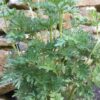Yarrow (Achillea millifolium)
Flowers: June to August. Height: 50cm (20in).
Yarrow is linked to Achilles, one of legends’ greatest heroes, as it was said that he tended the wounds of his men. Hence, most of its common names are linked back to war – Soldier’s Woundwort, Bloodwort, Staunchweed and ‘Herbe Militaris’. It was also known to the Chinese in ancient times with 49 Yarrow stalks being a form of divination, connected to the I Ching (Book of Changes). Pollen from Yarrow plants among other medicinal herbs was discovered at a burial site for a Neanderthal man (c 60,000 BC), indicated the importance of this plant throughout human history.
Medicinal: Having strong antiseptic qualities, this herb was good for the stomach, kidneys, headaches, fevers, infections, mad dog bites, as a digestive aid, for treating the kidneys and various urinary conditions. It was also used for pain relief and as a mild sedative. Yarrow tea was taken to stop internal bleeding. Yarrow contains an alkaloid which helps blood clot faster which made it a popular herb for battle wounds.
Culinary: Young leaves were used in salads and infused to make a herbal tea.
Magic & Myth: The herb related to the casting out of witches, and at one time was dedicated to the Devil.



